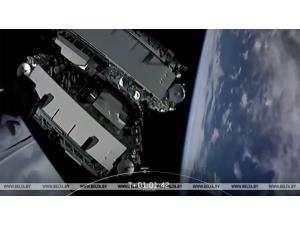



Date:08/01/20
 SpaceX successfully launched its third batch of 60 Starlink satellites — the second designated "production" hardware, after launching an initial group of 60 early in 2019 to test the technology. This group launched aboard a Falcon 9 with a first-stage booster that has already seen service in three previous missions, including two in 2019, one of which was the first bulk Starlink mission in May 2019.
SpaceX successfully launched its third batch of 60 Starlink satellites — the second designated "production" hardware, after launching an initial group of 60 early in 2019 to test the technology. This group launched aboard a Falcon 9 with a first-stage booster that has already seen service in three previous missions, including two in 2019, one of which was the first bulk Starlink mission in May 2019.
This launch took off from Cape Canaveral Air Force Station in Florida, and delivered the satellites to an orbit 290 km (around 180 miles) above Earth. The satellites will then perform diagnostics to ensure they’re in proper working order before moving to their final target orbits using their own onboard thrusters.
SpaceX also brought back the Falcon 9 booster used on this mission for a controlled landing aboard their "Of Course I Still Love You" drone landing ship. The company will also look to recover half of the payload fairing on this launch, with an attempt to catch the protective cargo covering using "Ms. Tree," one of two ships SpaceX has custom configured to catch the spacecraft component in a large net.
Likely to help mitigate criticism from the scientific community regarding the Starlink constellation’s potential to impact visibility of space from Earth, SpaceX also detailed the steps it’s taking to address this. It notes that though the satellites will be very visible immediately after launch, after between one and four months, they’ll climb to their final target orbit and re-orient themselves to become "significantly less visible from the ground." The company also says it’s "testing an experimental marketing treatment on one satellite" to see if that further reduces their effect on night sky visibility for high-sensitivity research instruments.
Starlink will provide high-speed, relatively low-latency broadband internet connectivity to customers on the ground, starting with those in the U.S. and Canada, with service potentially becoming available as early as later this year.
SpaceX successfully launches 60 more satellites for its Starlink broadband internet constellation
 SpaceX successfully launched its third batch of 60 Starlink satellites — the second designated "production" hardware, after launching an initial group of 60 early in 2019 to test the technology. This group launched aboard a Falcon 9 with a first-stage booster that has already seen service in three previous missions, including two in 2019, one of which was the first bulk Starlink mission in May 2019.
SpaceX successfully launched its third batch of 60 Starlink satellites — the second designated "production" hardware, after launching an initial group of 60 early in 2019 to test the technology. This group launched aboard a Falcon 9 with a first-stage booster that has already seen service in three previous missions, including two in 2019, one of which was the first bulk Starlink mission in May 2019.This launch took off from Cape Canaveral Air Force Station in Florida, and delivered the satellites to an orbit 290 km (around 180 miles) above Earth. The satellites will then perform diagnostics to ensure they’re in proper working order before moving to their final target orbits using their own onboard thrusters.
SpaceX also brought back the Falcon 9 booster used on this mission for a controlled landing aboard their "Of Course I Still Love You" drone landing ship. The company will also look to recover half of the payload fairing on this launch, with an attempt to catch the protective cargo covering using "Ms. Tree," one of two ships SpaceX has custom configured to catch the spacecraft component in a large net.
Likely to help mitigate criticism from the scientific community regarding the Starlink constellation’s potential to impact visibility of space from Earth, SpaceX also detailed the steps it’s taking to address this. It notes that though the satellites will be very visible immediately after launch, after between one and four months, they’ll climb to their final target orbit and re-orient themselves to become "significantly less visible from the ground." The company also says it’s "testing an experimental marketing treatment on one satellite" to see if that further reduces their effect on night sky visibility for high-sensitivity research instruments.
Starlink will provide high-speed, relatively low-latency broadband internet connectivity to customers on the ground, starting with those in the U.S. and Canada, with service potentially becoming available as early as later this year.
Views: 415
©ictnews.az. All rights reserved.Similar news
- Azerbaijani project to monitor disease via mobile phones
- Innovative educational system to be improved under presidential decree
- NTRC prolongs license of two TV and radio organizations for 6 years
- Azerbaijan establishes e-registry for medicines
- Azerbaijani museum introduces e-guide
- Nar Mobile opens “Nar Dunyasi” sales and service center in Siyazan city
- International conference on custom electronic services held in Baku
- OIC secretary general to attend COMSTECH meeting in Baku
- Azerbaijan develops earthquake warning system
- New law to regulate transition to digital broadcasting in Azerbaijan
- Azerbaijani State Social Protection Fund introduces electronic digital signature
- Intellectual traffic management system in Baku to be commissioned in December
- Tax Ministry of Azerbaijan started receiving video-addresses
- World Bank recommends Azerbaijan to speed up e-service introduction in real estate
- Azerbaijan to shift to electronic registration of real estate





















